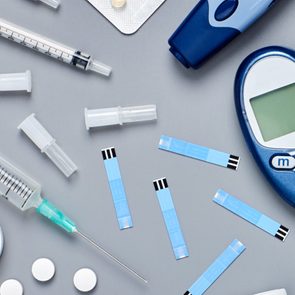This Woman with Diabetes Almost Lost Her Leg Due to an Ant Bite
Updated: Sep. 30, 2020
After an ant bite, a woman with type 1 diabetes was told she needed an amputation. Here's how doctors were able to save her leg using a variety of treatments and procedures.
 People with diabetes are at high risk of having serious problems with their feet. They can develop a type of nerve damage called peripheral neuropathy, which causes numbness, pain, and tingling. They can also have slow wound healing due to poor circulation. If someone with diabetes gets a cut, bite, blister, or foot ulcer, it can lead to chronic or serious infections—even amputations. But the obstacles don’t stop there: One in three people with diabetes develops peripheral artery disease, an artery-clogging condition that further restricts blood flow to the limbs.
People with diabetes are at high risk of having serious problems with their feet. They can develop a type of nerve damage called peripheral neuropathy, which causes numbness, pain, and tingling. They can also have slow wound healing due to poor circulation. If someone with diabetes gets a cut, bite, blister, or foot ulcer, it can lead to chronic or serious infections—even amputations. But the obstacles don’t stop there: One in three people with diabetes develops peripheral artery disease, an artery-clogging condition that further restricts blood flow to the limbs.
Carla Urff, 59, was only 11 years old when she was diagnosed with type 1 diabetes. Despite her diagnosis, she led a relatively healthy life until her mid-30s, when an ant bit her foot. Here, she shares how a physically small injury, made worse by diabetes, led her down a path of doctors, surgeries, and lifestyle changes. Eventually, she was able to avoid an amputation and persevered as a stronger and healthier person. (Here’s a guide to diabetes foot care.)
A bite seemed like a minor irritation
I’d been bitten by ants before and it had never been a big deal; they healed and went away without any issues. But when I was bitten by an ant on the top of my left foot over 20 years ago, I had no idea at the time how much my life was about to change. This ant bite just wouldn’t heal.
My type 1 diabetes diagnosis
I was diagnosed with type 1 diabetes when I was 11 years old. At the time it was incredibly surprising—my mother’s family didn’t have a history of diabetes and I didn’t know my father’s family. (Little did I know that when I connected with my father’s family in my 20s, I would meet a whole host of people with all the same health woes as me.)
I spent a month and a half in the hospital getting regulated on insulin, but after that, my childhood continued like any other. I was able to stay active and healthy, avoiding any complications from my diabetes.
Other than during my two pregnancies, at 24 and 26, I never had to take more than 30 units of insulin a day. (Here’s what you need to know about gestational diabetes in pregnancy.)
As I got older, I was constantly researching type 1 diabetes and trying to do everything I could to stay healthy. I knew that foot problems could be an issue; I remember being told as a kid that my feet were very important and to make sure I checked them daily for sores and went barefoot as little as possible.
I did my best to follow that advice, wearing running shoes almost all the time. But living in Florida, there were times when I wanted to kick them off—and it was on one of those days that I got the pesky ant bite. (Here are the best diabetic shoes for women.)
The ant bite that changed everything
When the bite not only didn’t heal but also kept getting worse, I made an appointment with my primary care doctor, who just recommended that I keep an eye on it. After a few months and no improvements, I was referred to a podiatrist.
The podiatrist thought the color in my foot was changing and referred me to a cardiologist—he suspected that my diabetes had prevented the bite from healing. It may also have been restricting blood flow to my foot. The cardiologist did not think urgent action was needed. He told me that I would probably end up being a candidate for angioplasty (a procedure that restores blood flow through an artery) in another five to 10 years, but for the time being everything would be fine.
But everything wasn’t fine. Just two years later I was back in his office, at which time I was told that angioplasty was no longer an option and that I would need my leg amputated.
It turned out I had peripheral artery disease and cardiovascular disease (something else that ran in my father’s family) and that the cardiovascular disease had progressed so rapidly there was nothing they could do: My body was making excess plaque too quickly. But I said no, amputation was not an option. I was going to find another way. (Read about a doctor who is doing everything he can to prevent amputations in Black patients with diabetes.)
Placing an artificial artery in the leg
As I researched more options and different doctors, I suffered from nerve pain and discomfort, mostly at night.
It would keep me up for hours, hours during which my mind would return to my kids, who were 10 and 12 at the time. I needed to fight this for them. But it got worse. The arteries continued to fill with plaque, and with no fresh blood flowing to my foot, it started to die. I eventually got gangrene in three of my toes.
I found an interventional cardiologist who agreed to perform a bypass and put an artificial artery in my leg. And it worked! The color came back and I didn’t lose a single toe.
The artificial artery lasted for eight healthy years until it failed. I went back to the same doctor, who said we could try harvesting an artery from my right leg—but only nine months passed after that procedure before I started to develop gangrenous toes again. (Put your best foot forward in these recommended sandals for diabetic women.)
Stents, bypass surgeries, and more
So we began a routine of monthly appointments in which my doctor would go in, clean the plaque out of the arteries and place stents as needed. Once we had my leg in fairly good shape, my doctor said we needed to see how my heart was doing.
More stents and bypass surgeries followed. Difficulties arose; as a long-term diabetic, my arteries are the size of a small child’s, which made these procedures challenging.
But I didn’t want to have open heart surgery and I eventually flew to Chicago, where surgeons at Loyola performed bypass using the Da Vinci robot. That was back in 2012, and I haven’t needed a heart procedure since.
Living with type 1 diabetes
Diabetes attacks every organ in the body. For some people it’s the kidneys or the eyes; for me, it was my heart and my arteries. But I refused to be a person who sat back and let it take over my body and my life.
Today, I take medication to protect my heart and manage my cholesterol in addition to my insulin, and I stay active and busy.
On the weekends I work weddings, and it’s not uncommon to find me on a ladder draping flowers or strings of twinkly lights. I eat lots of salads and vegetables and hardly any bread and I drink at least 1.5 liters of water a day.
It’s been a long road living with type 1 diabetes, but I consider myself fortunate and I plan to continue to lead an active, healthy, and happy life.
—As told to Alyssa Sybertz





















